
Recently Viewed


 Roband Grill Station 8 slice, smooth plates - GSA810S
Roband Grill Station 8 slice, smooth plates - GSA810S
560(W) X 490(D) X 220(H)mm

 Anvil Panini Press Single Flat Top Flat Bottom - TSS2001
Anvil Panini Press Single Flat Top Flat Bottom - TSS2001
410(W) x 205(H) x 378(D)mm


 Roband Grill Station 6 slice, smooth plates - GSA610S
Roband Grill Station 6 slice, smooth plates - GSA610S
435(W) X 490(D) X 220(H)mm

 Anvil Panini Press Double Flat Top Flat Bottom - TSS3001
Anvil Panini Press Double Flat Top Flat Bottom - TSS3001
570(W) x 205(H) x 378(D)mm

 Benchstar Large Double Contact Grill GH-813EE
Benchstar Large Double Contact Grill GH-813EE
860(W) x 395(D) x 210(H)mm

 Anvil Panini Press Single Ribbed Top Flat Bottom - TSS2000
Anvil Panini Press Single Ribbed Top Flat Bottom - TSS2000
410(W) x 205(H) x 378(D)mm

 Anvil Sandwich Press Flat Plate - TSA1009
Anvil Sandwich Press Flat Plate - TSA1009
355(W) x 327(H) x 466(D)mm

 Anvil Jaffle Maker - JMA0001
Anvil Jaffle Maker - JMA0001
382(W) x 236(H) x 271(D)mm


 Roband Grill Station 8 slice, smooth plates, 13 Amp - GSA815S
Roband Grill Station 8 slice, smooth plates, 13 Amp - GSA815S
560(W) X 490(D) X 220(H)mm


 Apuro Double Contact Grill Ribbed Plates with Timer - FC383-A
Apuro Double Contact Grill Ribbed Plates with Timer - FC383-A
550(W) x 210(H) x 295(D)mm


 Apuro Double Contact Grill Ribbed Top Plates with Timer - FC385-A
Apuro Double Contact Grill Ribbed Top Plates with Timer - FC385-A
550(W) x 210(H) x 395(D)mm

 Benchstar Large Single Contact Grill GH-811EE
Benchstar Large Single Contact Grill GH-811EE
415(W) x 395(D) x 210(H)mm


 Roband Grill Station 8 slice, smooth non stick plates - GSA810ST
Roband Grill Station 8 slice, smooth non stick plates - GSA810ST
560(W) X 490(D) X 220(H)mm


 Roband Grill Station 6 slice, smooth non stick plates - GSA610ST
Roband Grill Station 6 slice, smooth non stick plates - GSA610ST
435(W) X 490(D) X 220(H)mm

 Anvil Panini Press Double Ribbed Top Flat Bottom - TSS3000
Anvil Panini Press Double Ribbed Top Flat Bottom - TSS3000
570(W) x 205(H) x 378(D)mm

 Apuro Bistro Double Contact Grill - CU605-A
Apuro Bistro Double Contact Grill - CU605-A
570(W) x 200(H) x 210(D)mm


 Apuro Bistro Large Contact Grill - CU603-A
Apuro Bistro Large Contact Grill - CU603-A
410(W) x 200(H) x 310(D)mm


 Apuro Double Contact Grill Flat / Ribbed Plates with Timer - FC386-A
Apuro Double Contact Grill Flat / Ribbed Plates with Timer - FC386-A
550(W) x 210(H) x 295(D)mm


 Apuro Large Contact Grill Flat Plates with Timer - CU607-A
Apuro Large Contact Grill Flat Plates with Timer - CU607-A
480(W) x 215(H) x 310(D)mm
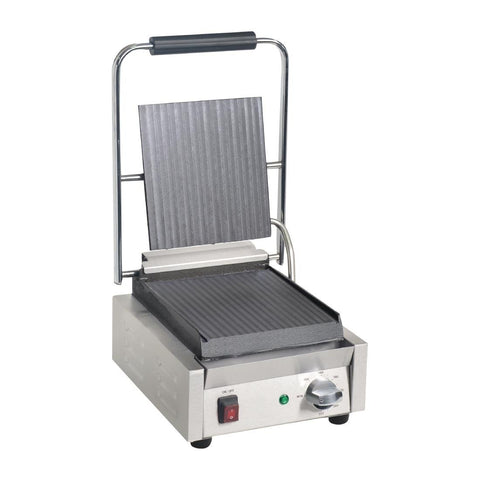

 Apuro Single Contact Grill Flat Plates - DY996-A
Apuro Single Contact Grill Flat Plates - DY996-A
290(W) x 210(H) x 395(D)mm


 Apuro Bistro Double Ribbed Contact Grill - DY994-A
Apuro Bistro Double Ribbed Contact Grill - DY994-A
550(W) x 210(H) x 295(D)mm


 Roband Grill Station 6 slice, non stick with ribbed top plate - GSA610RT
Roband Grill Station 6 slice, non stick with ribbed top plate - GSA610RT
435(W) X 490(D) X 220(H)mm


 Apuro Single Contact Grill Ribbed Plates - DY993-A
Apuro Single Contact Grill Ribbed Plates - DY993-A
290(W) x 210(H) x 395(D)mm

 Benchstar Electric Grill Station GH-819
Benchstar Electric Grill Station GH-819
540(W) x 510(D) x 247(H)mm


 Roband Grill Station 8 slice, non stick with ribbed top plate - GSA810RT
Roband Grill Station 8 slice, non stick with ribbed top plate - GSA810RT
560(W) X 490(D) X 220(H)mm


 Apuro Extra Large Contact Grill Ribbed & Flat Plate - CU609-A
Apuro Extra Large Contact Grill Ribbed & Flat Plate - CU609-A
430(W) x 200(H) x 310(D)mm


 Apuro Bistro Ribbed Contact Grill - CU600-A
Apuro Bistro Ribbed Contact Grill - CU600-A
310(W) x 200(H) x 310(D)mm


 Roband Grill Station 8 slice, smooth non stick plates, 13 Amp - GSA815ST
Roband Grill Station 8 slice, smooth non stick plates, 13 Amp - GSA815ST
560(W) X 490(D) X 220(H)mm
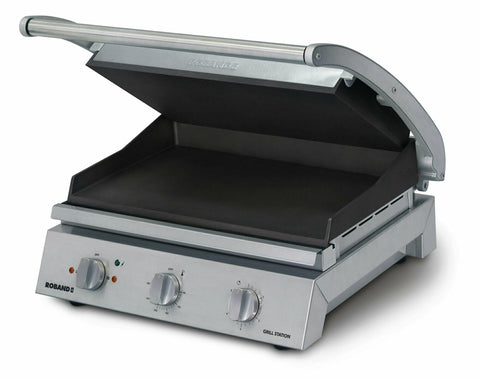

 Roband Grill Station 8 slice, non stick with ribbed top plate, 13 Amp - GSA815RT
Roband Grill Station 8 slice, non stick with ribbed top plate, 13 Amp - GSA815RT
560(W) X 490(D) X 220(H)mm


 Roband Grill Station 6 slice, ribbed top plate - GSA610R
Roband Grill Station 6 slice, ribbed top plate - GSA610R
435(W) X 490(D) X 220(H)mm
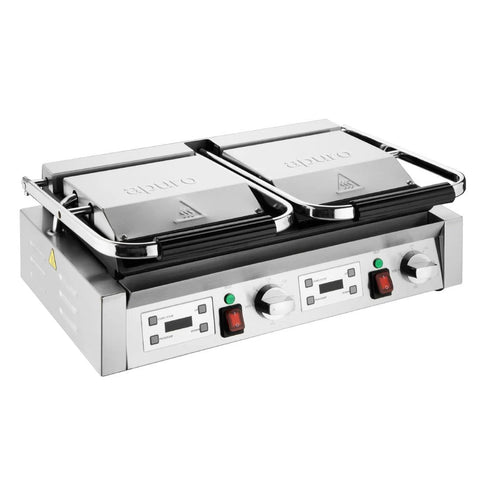

 Apuro Double Half Ribbed Contact Grill - CU613-A
Apuro Double Half Ribbed Contact Grill - CU613-A
550(W) x 210(H) x 210(D)mm
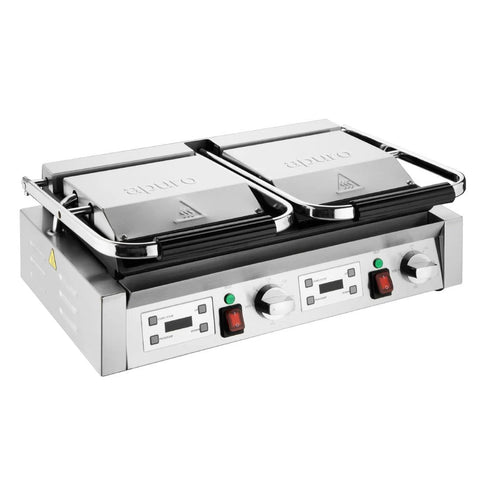

 Apuro Double Contact Grill Ribbed Plates with Timer - CU611-A
Apuro Double Contact Grill Ribbed Plates with Timer - CU611-A
550(W) x 210(H) x 210(D)mm


 Apuro Double Contact Grill Flat Plates with Timer - CU610-A
Apuro Double Contact Grill Flat Plates with Timer - CU610-A
550(W) x 210(H) x 210(D)mm


 Apuro Extra Large Contact Grill Ribbed Plate - CU608-A
Apuro Extra Large Contact Grill Ribbed Plate - CU608-A
430(W) x 200(H) x 310(D)mm


 Apuro Bistro Double Ribbed Contact Grill - CU604-A
Apuro Bistro Double Ribbed Contact Grill - CU604-A
570(W) x 200(H) x 210(D)mm


 Apuro Bistro Large Ribbed Contact Grill - CU602-A
Apuro Bistro Large Ribbed Contact Grill - CU602-A
410(W) x 200(H) x 310(D)mm


 Apuro Bistro Contact Grill - CU601-A
Apuro Bistro Contact Grill - CU601-A
310(W) x 200(H) x 310(D)mm
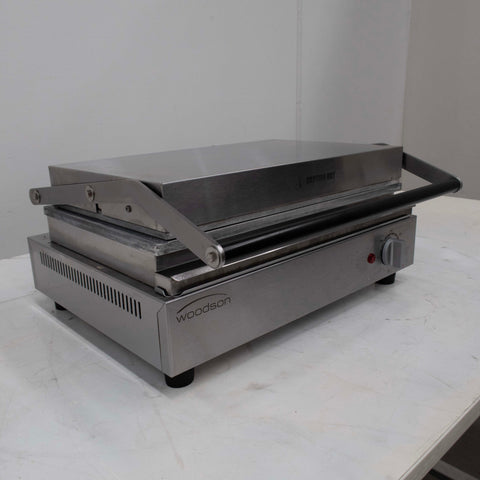

 Woodson W.CT8 Contact Grill - 797880
Woodson W.CT8 Contact Grill - 797880
500W x 450D x 260Hmm

 Benchstar GH-813EE Double Contact Grill - 909110
Benchstar GH-813EE Double Contact Grill - 909110
840W x 395D x 216Hmm


 Apuro DY998-A-02 Contact Grill - 836877
Apuro DY998-A-02 Contact Grill - 836877
540W x 390D x 200Hmm

 Electrolux SpeeDelight High Speed Grill - HSG3RPRU2
Electrolux SpeeDelight High Speed Grill - HSG3RPRU2
370(W) x 683(D) x 619(H)mm


855W x 905D x 1110Hmm


1200W x 1025D x 840Hmm
1200W x 840D x 1025Hmm


1310W x 1075D x 730Hmm
1310W x 730D x 1075Hmm


 Apuro FC383-A-02 Contact Grill - 813852
Apuro FC383-A-02 Contact Grill - 813852
540W x 200D x 400Hmm


 Roband GSA610ST Contact Grill - 858534
Roband GSA610ST Contact Grill - 858534
435W x 220D x 490Hmm


 Blue Seal G596-LS Char Grill & Griddle - 878763
Blue Seal G596-LS Char Grill & Griddle - 878763
900W x 1090D x 810Hmm
900W x 810D x 1090Hmm


1000W x 1420D x 850Hmm
1000W x 850D x 1420Hmm


615W x 175D x 450Hmm
615W x 450D x 175Hmm


 Semak SCG12 Charcoal Grill - 870388
Semak SCG12 Charcoal Grill - 870388
840W x 335D x 860Hmm
840W x 860D x 335Hmm

 Century CP2968 Grill - 839838
Century CP2968 Grill - 839838
610W x 410D x 590Hmm
610W x 590D x 410Hmm


900W x 1020D x 840Hmm
900W x 840D x 1020Hmm
Whether you’re a cafe or restaurant, incorporating a commercial sandwich press into your kitchen setup is an often-underestimated addition. They’re remarkably versatile, not only delivering perfectly crisp paninis and toasted sandwiches but also for searing things like salmon and steak for those satisfying grill marks. Restaurant-grade sandwich presses can help you increase your menu offerings while also enhancing the quality of your food.
If you’re looking for the top brands in the industry, you’ll find them here. Shop the range at Restaurant Equipment Online and order online today with Australia-wide delivery.
The key features to look for include the press you want—whether smooth or with grill lines—and any automation you may find beneficial. If you’re trying to streamline the number of appliances you need, combination models with both formats can mean you get the kind of functionality you’d expect from a commercial grill.
When it comes to using your sandwich press, some models simply require you to close the lid when cooking, and your commercial sandwich press will toast whatever you’re making. Others have computerised options with timers, making it simpler to get the perfect results every time.
A sandwich press and a sandwich maker are essentially the same appliance, delivering crispy, toasted sandwiches and paninis. However, their specifications are slightly different. Sandwich makers that you’d find in homes are typically smaller and made for occasional, daily use. Commercial sandwich presses are larger, making it easier to make higher volumes of food at the same time.
Commercial models are also made to be more resilient and able to withstand the high use that your cafe, takeaway establishment or restaurant demands. They’re also often more powerful and deliver a more consistent level of heat. Certain models may also have additional functionality, like pre-set timers and settings.
As with any commercial kitchen appliance, opting for materials that are both resilient to frequent use and easy to clean should be your top priority. We recommend looking for a commercial sandwich press that’s non-stick, with aluminium options, in particular, being quick to heat up and cool down again after you switch your sandwich press off for the day.
Cleaning commercial sandwich presses is fairly straightforward and should be done every day both for food health and safety but also to extend the lifespan of your sandwich press. Between each cooking session, wipe the plates down to ensure you’re removing any burnt-on residue and to remove excess oil that can compromise the quality of your food. Many models will come with a grease drain, helping to remove oil runoff from the food you’re preparing, whether that’s paninis, grilled vegetables or meat.
For deeper cleans, start by switching off the unit entirely and letting it cool completely. Next, begin the cleaning process by using a grill scraper to remove any food residue and leftover oil. It’s essential that you’re using one that won’t scratch or compromise the materials of the plates. Wash them with a gentle dish detergent and put the grease tray into the dishwasher for a more thorough cleaning.
Each model of sandwich press will vary slightly, between brands and whether you have a flat plate model or a ridged grilling plate. We recommend looking at the manufacturer’s instructions for cleaning to make sure you’re following the best practices.
Commercial sandwich presses can be used for a far wider range of menu items than sandwiches alone. In fact, they’re an ideal option for kitchens with more limited space and can even be used as a substitute for electric griddles.
Along with your obvious choices like toasted sandwiches and paninis, you can also make quesadillas, grill vegetables or even sear things like chicken, steak and fish. With their high heat, different plate options, and easy-to-use design, you can expand your menu significantly with just one appliance.
The choice between a ribbed plate and a flat plate comes down to personal preference. Depending on what you’re preparing, you may want the grill lines that a ribbed model offers or prefer an extra even and crisp result with a flat plate. If you’re undecided, you can also get commercial sandwich presses with both, giving you more choice and versatility to cook however you want.
The perfect temperature can depend on the type of bread you’re using, how thick your slices are and what you’ve put inside. Generally speaking, to ensure a crispy outside and gooey melted cheese on the inside, you’ll want to aim for around 170℃ to 200℃. Many commercial models of sandwich press come with specific heat settings and timers, too, ensuring you get the best results every time with even less effort.
The lifespan will depend on how frequently you use your sandwich press, how well you maintain it and how it’s used. With regular maintenance and care, your commercial sandwich press can last for several years.